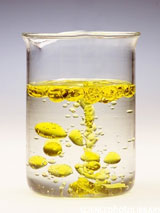In section one, you learned that a mixture is a combination of two or more pure substances that are not chemically combined.
![]() Watch the following video for a brief introduction to mixtures.
Watch the following video for a brief introduction to mixtures.
Source: Mixtures, BioEd Online, YouTube
There are two types of mixtures, homogeneous mixtures and heterogeneous mixtures.

Source: Vinegar, Food Service Direct
Homogeneous means "the same throughout." A homogeneous mixture has the same appearance and composition throughout. You cannot see the different parts of a homogeneous mixture. Vinegar is an example of a homogeneous mixture of acetic acid and water.
Heterogeneous means "different throughout." A heterogeneous mixture has large parts that are different from each other. You can see the different parts of a heterogeneous mixture. Oil in water is an example of a heterogeneous mixture. You can see both the oil and water in the image to the right.

Source: Oil and Water, Charles D. Winters, Science Photo Library
The substances in a mixture keep their properties. Each substance in a mixture has the same chemical makeup it had before the mixture was made. In the picture of the oil in water above, both the oil and water have the same properties they had before they were combined.
![]() Mixtures can be separated physically. The video below shows how to separate a mixture of iron, sand, and salt.
Mixtures can be separated physically. The video below shows how to separate a mixture of iron, sand, and salt.
Source: Separating a Mixture, topsailscience, YouTube